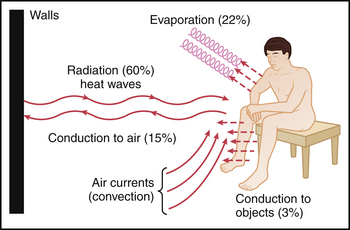69 CASE 69
PATHOPHYSIOLOGY OF KEY SYMPTOMS
Body core temperature reflects the balance of heat generation and heat transfer with the environment. Heat generation is predominantly from metabolism and from muscle movement. Heat exchange with the environment occurs by conduction, convection, radiation, and evaporation (Fig. 69-1). Conduction is the direct transfer of heat by contact. Conductive exchange of heat with the air is minimized by the insulating ability of the skin and by reducing cutaneous blood flow, particularly to the extremities. Clothing with insulating capabilities also diminishes the conductive loss of heat to the air. Convection enhances heat exchange by exchange of air in contact with the body surface. Radiation allows transfer of heat by infrared energy. Evaporation facilitates the cooling of skin by sweating or when the skin surface becomes wet.
< div class='tao-gold-member'>
Stay updated, free articles. Join our Telegram channel

Full access? Get Clinical Tree



